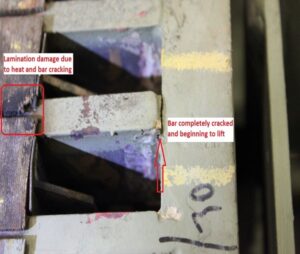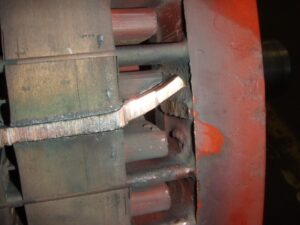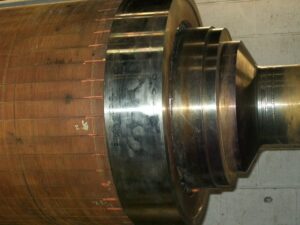How do 2-Pole Electric Motor Rotor Bars Crack? - HECO
August 4, 2016
Rotor bars of 2-pole (3600RPM) rotors are subjected to high stresses caused by repeated starting, thermal expansion and centrifugal forces. The repeated starting with resultant cyclic forces causes the bars to loosen. This is because the rotating magnetic stator field applies rapidly alternating forces to each rotor bar, diminishing in intensity and frequency as the motor accelerates. The longer the starting period, the more cyclic forces the rotor cage must endure.

Note: This is not a 2-pole rotor but this image shows what cracking of bars looks like
Thermal expansion occurs due to the differential expansion of copper verses steel. Copper will expand at a much faster rate than steel laminations when heated. The bar will grow in width and height but due to small bar cross sectional areas the growth is minimal. Lengthwise the bar grows the most and can exceed the lamination growth by 1/16 of an inch or more. This linear bar expansion causes endwise movement of the bars in the slots, scraping back and forth over time, eventually causing a loose fit.

Note: This is not a 2-pole rotor but this image shows a bar lifting out of the rotor slot
The centrifugal forces present in 2-pole rotors necessitate the use of steel (typically stainless) retainer rings which are shrunk onto the copper shorting ring. These retainer rings must have the proper interference fit to the shorting ring or out of balance problems will occur. These rings (in some designs) must also allow for linear thermal expansion of the shorting ring within the retainer ring. The proper clearance must be present or bowing may occur causing out of balance problems. The combination of thermal expansion and centrifugal forces also cause the bars to bend at the end of the rotor slot. This bending causes bar fatigue and eventually bar cracks.

You can see the stainless steel retaining rings of this 2-pole rotor in this image.
Posted in Equipment Management, Predictive
